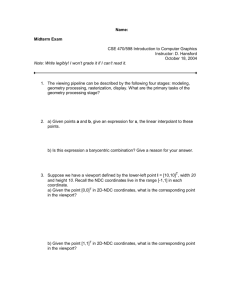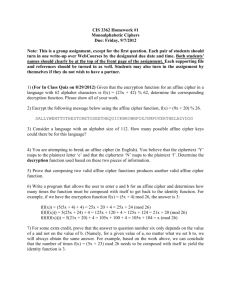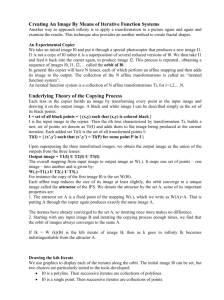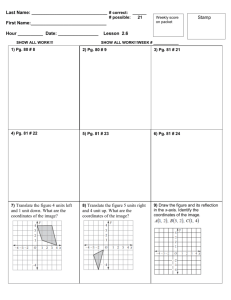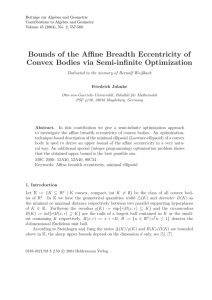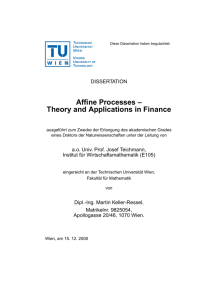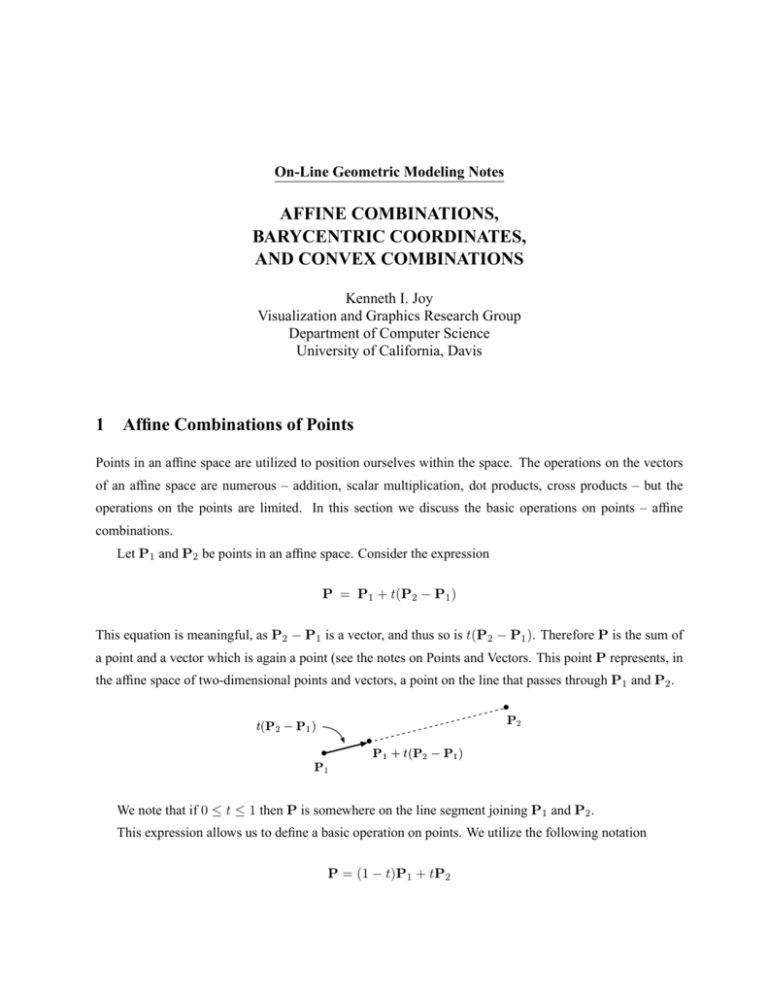
On-Line Geometric Modeling Notes
AFFINE COMBINATIONS,
BARYCENTRIC COORDINATES,
AND CONVEX COMBINATIONS
Kenneth I. Joy
Visualization and Graphics Research Group
Department of Computer Science
University of California, Davis
1
Affine Combinations of Points
Points in an affine space are utilized to position ourselves within the space. The operations on the vectors
of an affine space are numerous – addition, scalar multiplication, dot products, cross products – but the
operations on the points are limited. In this section we discuss the basic operations on points – affine
combinations.
Let P1 and P2 be points in an affine space. Consider the expression
P = P1 + t(P2 − P1 )
This equation is meaningful, as P2 − P1 is a vector, and thus so is t(P2 − P1 ). Therefore P is the sum of
a point and a vector which is again a point (see the notes on Points and Vectors. This point P represents, in
the affine space of two-dimensional points and vectors, a point on the line that passes through P1 and P2 .
We note that if 0 ≤ t ≤ 1 then P is somewhere on the line segment joining P1 and P2 .
This expression allows us to define a basic operation on points. We utilize the following notation
P = (1 − t)P1 + tP2
to mean that P is the point defined by
P = P1 + t(P2 − P1 )
We can then define an affine combination of two points P1 and P2 to be
P = α1 P1 + α2 P2
where α1 + α2 = 1. The form P = (1 − t)P1 + tP2 is shown to be an affine transformation by setting
α2 = t.
We can generalize this to define an affine combination of an arbitrary number of points. If P1 , P2 , ..., Pn
are points and α1 , α2 , ..., αn are scalars such that α1 + α2 + · · · + αn = 1, then
α1 P1 + α2 P2 + · · · + αn Pn
is defined to be the point
P1 + α2 (P2 − P1 ) + · · · + αn (Pn − P1 )
To construct an excellent example of an affine combination consider three points P1 , P2 and P3 . A
point P defined by
P = α1 P1 + α2 P2 + α3 P3
where α1 + α2 + α3 = 1, gives a point in the triangle 4P1 P2 P3 . We note that the definition of affine
combination defines this point to be
P = P1 + α2 (P2 − P1 ) + α3 (P3 − P1 )
The following illustration shows the point P generated when α1 = α2 =
2
1
4
and α3 = 12 .
In fact, it can be easily shown that if 0 ≤ α1, α2, α3 ≤ 1 then the point P will be within (or on the
boundary) of the triangle. If any αi is less than zero or greater than one, then the point will lie outside the
triangle. If any αi is zero, then the point will lie on the boundary of the triangle.
2
Barycentric Coordinates
Given a frame (~v1 , ~v2 , ..., ~vn , O) for an affine space A, we can write any point P uniquely as
P = p1~v1 + p2~v2 + · · · + pn~vn + O
If we define points Pi by
P0 = O
P1 = O + ~v1
P2 = O + ~v2
..
.
Pn = O + ~vn
and define p0 to be
p0 = 1 − (p1 + p2 + · · · + pn )
3
then we can see that P can be equivalently written as
P = p 0 P0 + p 1 P 1 + p 2 P 2 + · · · + p n Pn
where p0 + p1 + p2 + · · · + pn = 1
In this form, the values (p0 , p1 , p2 , ..., pn ) are called the barycentric coordinates of P relative to the
points (P0 , P1 , P2 , ..., Pn )
Vectors can also be expressed in barycentric form by letting
u0 = −(u1 + u2 + · · · + un )
Then we have
~u = u0 P0 + u1 P1 + u2 P2 + · · · + un Pn
where now we have that u0 + u1 + u2 + · · · + un = 0.
To give a simple example of barycentric coordinates, consider two points P1 and P2 in the plane. If α1
and α2 are scalars such that α1 + α2 = 1, then the point P defined by
P = α1 P1 + α2 P2
is a point on the line that passes through P1 and P2 . If 0 ≤ α1 , α2 ≤ 1 then the point P is on the line
segment joining P1 and P2 . The following figure shows an example of a line and three points P, Q and R.
These points were generated using the following αs:
• P : α1 = 31 , α2 =
2
3
• Q : α1 = 34 , α2 =
1
4
• R : α1 = 43 , α2 = − 13
4
To give a slightly more complex example of barycentric coordinates, consider three points P1 , P2 , P3
in the plane. If α1 , α2 , α3 are scalars such that α1 + α2 + α3 = 1, then the point P defined by
P = α1 P1 + α2 P2 + α3 P3
is a point on the plane of the triangle formed by P1 , P2 , P3 . The point is within the triangle 4P1 P2 P3 if
0 ≤ α1 , α2 , α3 ≤ 1. If any of the α’s is less than zero or greater than one, the point P is outside the triangle.
If any of the α’s is zero, we reduce to the example above and note that P is on one of the lines joining the
vertices of the triangle. The following figure shows an example of such a triangle and three points P, Q and
R, these points were calculated using the following α’s:
• P : α1 = α2 = 41 , α3 = 12 .
• Q : α1 = 12 , α2 = 34 , α3 = − 14 .
• R : α1 = 0, α2 = 34 , α3 = 14 .
5
Thus barycentric coordinates are another method of introducing coordinates into an affine space. If the
coordinates sum to one, they represent a point ; if the coordinates sum to zero, they represent a vector.
3
Convex Combinations
Given a set of points P0 , P1 , ..., Pn , we can form affine combinations of these points by selecting α0 , α1 , ..., αn ,
with α0 + α1 + · · · + αn = 1 and form the point
P = α0 P0 + α1 P1 + · · · + αn Pn
If each αi is such that 0 ≤ αi ≤ 1, then the points P is called a convex combination of the points
P0 , P1 , ..., Pn .
To give a simple example of this, consider two points P0 and P1 . Any point P on the line passing
through these two points can be written as P = α0 P0 + α1 P1 which is an affine combination of the two
points. The points Q and R in the following figure are affine combinations of P0 and P1 .
However, the point Q is a convex combination, as 0 ≤ α0 , α1 ≤ 1, and any point on the line segment
joining P0 and P1 can be written in this way.
Given any set of points, we say that the set is a convex set, if given any two points of the set, any convex
combination of these two points is also in the set. The following figure illustrates both a convex set (on the
left) and a non-convex set (on the right).
6
This concept is actually quite intuitive, in that if one can draw a straight line between two points of the
set that is not completely contained within the set, the the set is non-convex.
The set of all points P that can be written as convex combinations of P0 , P1 , ..., Pn is called the
convex hull of the points P0 , P1 , ..., Pn . This convex hull is the smallest convex set that contains the set of
points P0 , P1 , ..., Pn . The following figure illustrates the convex hull of a set of six points:
One of the six points does not contribute to the boundary of the convex hull. If one looked closely at
the coordinates of the point, one would find that this point could be written as a convex combination of the
other five.
4
Acknowledgement
Most of this material was adapted from Tony DeRose’s wonderful treatment of affine spaces given in [1].
7
References
[1] Tony DeRose. Coordinate-free geometric programming. Technical Report 89-09-16, Department of
Computer Science and Engineering, University of Washington, Seattle, Washington, 1988.
All contents copyright (c) 1996, 1997, 1998, 1999
Computer Science Department, University of California, Davis
All rights reserved.
8



